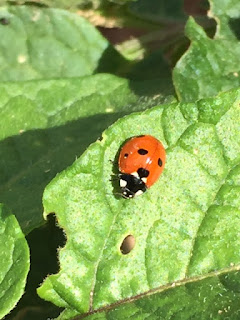Last year, while working at the farm, Richard and I witnessed one of Nature's most spectacular phenomena: a bee swarm. Honeybee colonies are ruled by a single queen, but sometimes, a new queen hatches while the old queen still rules, so the colony divides itself and half the worker bees and one queen leave their home in search of new digs.
 |
| Honeybees are Important Pollinators |
Usually, the departing group, or swarm, will settle nearby, often in a tree or shrub, until suitable housing is found. Last year's farm swarm was unusual because the bees left one hive to settle next door in a vacant box. From start to finish, the entire fascinating process took about an hour and I filmed most of the action. View the video here: Honeybee Swarm
While transplanting tomato and pepper plants to the farm last week, another large honeybee colony swarmed and settled into convenient housing next door, but due to the busyness of transplanting, we missed the show. By the time I observed occupants in the hive box, empty that morning, the residents were working diligently to clean and tidy the new home.
 |
| Honeybee Swarm Captured by Richard |
As beekeepers, Richard and I owe gratitude to others who teach us how to care for these fascinating creatures. Tate Poarch, Willard, Howard and Richard Greene, Bruce Hamby, Scott Barlow, Pete Penley and others often share knowledge, time and resources with us. Recently, a new generation of beekeepers is emerging and we rejoice to see young people include honeybees as part of the family. Our son, Clark Barlowe, chef owner of Heirloom Restaurant, currently hosts ten rooftop honeybee colonies and the bees share honey with restaurant guests. Bob Peters, master mixologist at The Ritz Carlton's bar, The Punch Room, also helps manage the hotel's rooftop hives and often includes honey in his unique and innovative concoctions.
 |
| Clark Barlowe & Bob Peters With Honey Harvest (Photo: Peter Taylor) |
Recently, Willard Greene shared three honeybee colonies with Drew Parrish, a young man who, along with his wife, plans to grow organic fruits and vegetables near Winston-Salem. Eager to learn and excited to incorporate honeybees in his family's venture, Drew represents a growing population of young beekeepers who appreciate the balance of Nature and Human.
 |
| Beekeeper Drew Parrish With Honeybee Hives |
As we approach National Pollinator Week, June 20-26, plan to celebrate by becoming a beekeeper, befriending a beekeeper or just purchasing some of the magic elixir shared by honeybees.
 |
| Fresh Strawberry Bruschetta With Honey Drizzle |
|
Fresh Strawberry Bruschetta With Honey Drizzle
Take advantage of strawberry and arugula seasons with this treat. For best flavor, be sure to use local honey.
For each serving:
Simmer 1 tablespoon balsamic vinegar (I used strawberry infused) in a small pot until slightly reduced, about 4 minutes. While balsamic is warm, add 1/2 cup chopped baby arugula leaves and about a tablespoon toasted pine nuts and stir to combine.
Heat 1 tablespoon grapeseed oil in a skillet, add 1 slice sourdough bread, brown both sides and drain on paper towel.
While bread is warm, spread a generous smear of fresh chevre (goat cheese) over one side. Top with the balsamic/arugula mixture and add fresh sliced strawberries. Drizzle about a teaspoon of local honey over.























